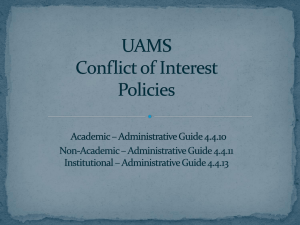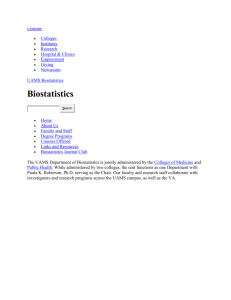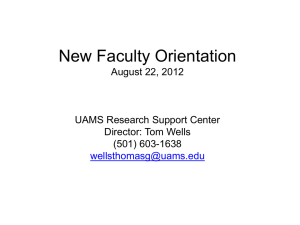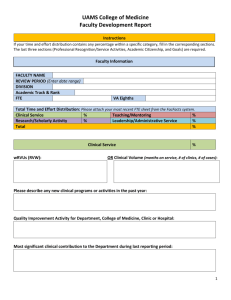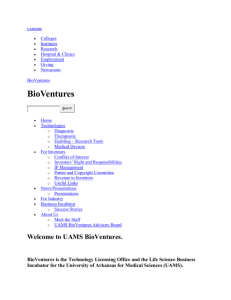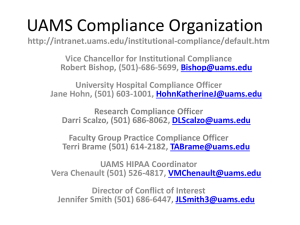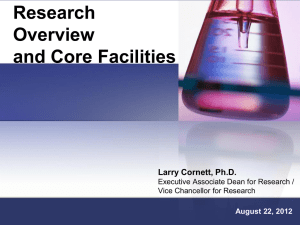The Chancellor of the University of Arkansas for Medical Sciences
advertisement
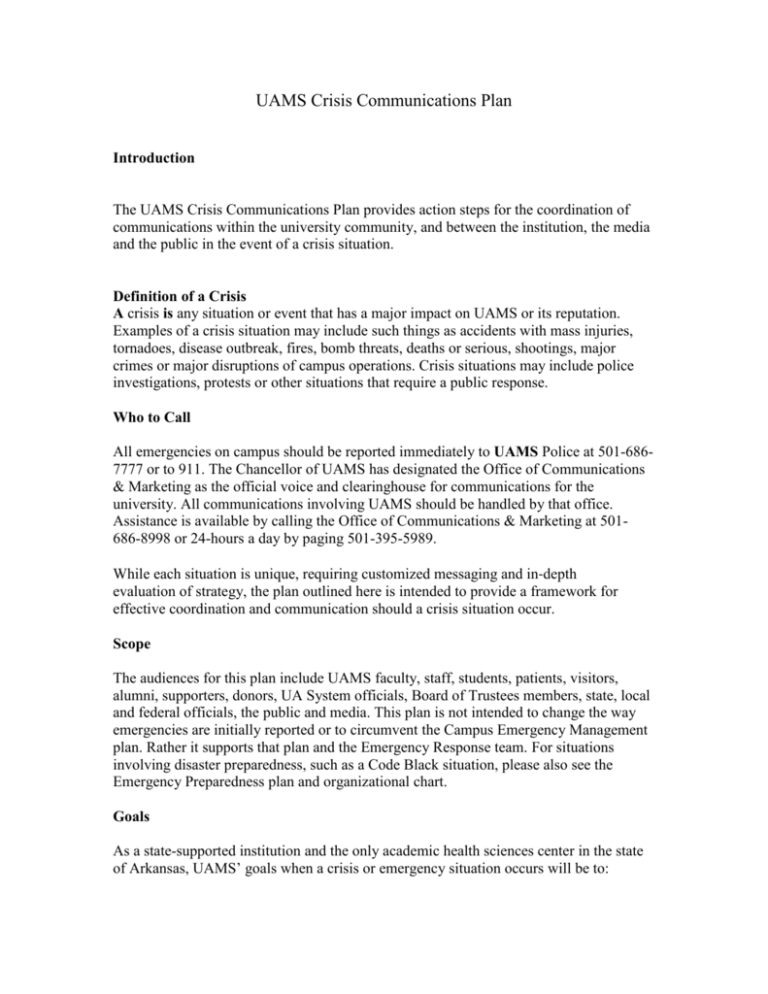
UAMS Crisis Communications Plan Introduction The UAMS Crisis Communications Plan provides action steps for the coordination of communications within the university community, and between the institution, the media and the public in the event of a crisis situation. Definition of a Crisis A crisis is any situation or event that has a major impact on UAMS or its reputation. Examples of a crisis situation may include such things as accidents with mass injuries, tornadoes, disease outbreak, fires, bomb threats, deaths or serious, shootings, major crimes or major disruptions of campus operations. Crisis situations may include police investigations, protests or other situations that require a public response. Who to Call All emergencies on campus should be reported immediately to UAMS Police at 501-6867777 or to 911. The Chancellor of UAMS has designated the Office of Communications & Marketing as the official voice and clearinghouse for communications for the university. All communications involving UAMS should be handled by that office. Assistance is available by calling the Office of Communications & Marketing at 501686-8998 or 24-hours a day by paging 501-395-5989. While each situation is unique, requiring customized messaging and in‐depth evaluation of strategy, the plan outlined here is intended to provide a framework for effective coordination and communication should a crisis situation occur. Scope The audiences for this plan include UAMS faculty, staff, students, patients, visitors, alumni, supporters, donors, UA System officials, Board of Trustees members, state, local and federal officials, the public and media. This plan is not intended to change the way emergencies are initially reported or to circumvent the Campus Emergency Management plan. Rather it supports that plan and the Emergency Response team. For situations involving disaster preparedness, such as a Code Black situation, please also see the Emergency Preparedness plan and organizational chart. Goals As a state-supported institution and the only academic health sciences center in the state of Arkansas, UAMS’ goals when a crisis or emergency situation occurs will be to: Communicate openly, honestly and proactively with the University’s constituents, recognizing the importance of avoiding panic, speaking with one voice, minimizing rumors and balancing the public’s right to know under the Arkansas Freedom of Information Act with individuals’ legal rights to privacy (HIPAA, FERPA). UAMS will respond quickly to immediate threats to the well‐being of patients, visitors, students, faculty, staff and visitors. In situations involving threats to safety and security, the Clery Act requires UAMS to issue timely notices to the university community. If an incident falls under the Clery Act, UAMS will issue a statement immediately. Communications & Marketing staff will provide regular updates of information to media, patients, visitors, staff, students and the public as facts become available. Procedures: 1. Crisis Communications Team Convened If the Emergency Preparedness team or events warrant the designation of a crisis situation, the Associate Vice Chancellor for Communications & Marketing shall assume the role of public information officer and convene the Crisis Communications Team. That Core Team will include: Associate Vice Chancellor for Communications & Marketing Chancellor Vice Chancellor for Communications & Marketing Hospital Director or appropriate department head or chief in affected area(s) Director of Communications Director of University Relations Director of Web Center Manager of Media Relations Vice Chancellor for Administration & Governmental Relations Associate Vice Chancellor for Human Resources Emergency Preparedness Manager Director of Telecommunications Other personnel will be added to this core team as needed.to form the larger Crisis Communication Team, which will then formulate a response based on the nature of the crisis. Initial Steps. 2. Spokesperson is designated. In most cases the Associate Vice Chancellor for Communications & Marketing and/or the Chancellor of UAMS will serve as official UAMS spokespersons. However, in some situations, other leaders in various UAMS areas who have direct knowledge of the situation or appropriate expertise such as physicians or deans of colleges or directors of the hospital or institutes may be asked to speak on behalf of UAMS. That will be determined by the Crisis Communications team. 3. Location of Communications Command Center Determined. The Cranford Conference Room or the Atrium area of the College of Public Health will be used as the command center where media will be met by Communications staff and given regular updates. UAMS will also utilize its uplink capabilities to provide regular updates 4. Facts gathered and statements written for distribution to patients and families, media, students, staff, and key constituents including UA System President and Board, Governor, elected officials, donors and supporters. 5. UAMS leaders, staff , students, patients and constituents are notified by mass emails, college list servs, UAMS Web site postings, phone trees, and other vehicles working with appropriate UAMS and UA System leaders. 6. Updates to UAMS community, Constituents and media are regularly issued 7. Government agencies notifed – As appropriate, UAMS Communications & Marketing will interace with other state and local agencies such as the Department of Health and Department of Human Services, mayors office. 8. Media Briefings/News Conferences – If needed briefings can be held with UAMS officials and media. Uplink can also be utilized. 9. News Releases will be prepared and distributed as needed. 10. Campus Forum – UAMS leaders will convene a campus forum if needed 11. Local Community Forum – If the situation has an impact on local residents, UAMS Communications & Marketing will distribute information to that neighborhood or arrange for a community forum where UAMS leaders can answer questions. A telephone hotline answered by UAMS Communications & Marketing staff to provide information can also be established. 12. Information for Hospital and Campus operators – Statements to use in answering questions will also be distributed to UAMS operators. Information for use in referring phone calls will also be distributed. 13. Information and regular updates will be posted to the two UAMS Web sites as well as to Facebook, Twitter and other social media. 14. Social media monitoring - Web Center and other Communications staff will continually monitor blogs, and other social media for comments and issue responses as appropriate. Debriefing. After the crisis has ended, the Crisis Communications Team should reconvene within a week to review all actions taken as a result of the crisis and determine effectiveness and efficiency of operations and make any needed changes to the Crisis Communications Plan.
